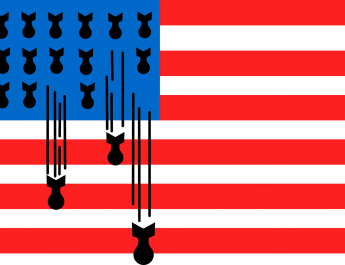An inflationary tsunami is passing through the world economy, creating economic disorder—in some cases acute political crisis—in every country it touches. This is gathering momentum as the U.S., which is leading other Global North economies, attempts to control inflation by rapidly raising interest rates—forcing the Global North economies into recession.
The Global South economies have been thereby struck by a quadruple whammy producing still more severe stagflation, rising inflation, and slowing growth than in the Global North. First, rising U.S. interest rates force up the dollar’s exchange rate against the currencies of developing countries, increasing import prices that are usually set in dollars, thereby worsening inflation for these developing countries. Second, the dollar’s climb against the currencies of developing countries increases the cost in their currencies of repaying international debts, which are dollar-priced…
The U.S. claims that this global inflation, and the downward pressure on living standards it creates, is due to the Ukraine war—and that therefore, countries should blame and unite against Russia. But a brief look at the facts refutes this claim.
The Ukraine war started on February 24, 2022, but U.S. inflation had already been rising sharply for nearly two years before that. U.S. price rises were 0.1 percent in May 2020, but by January 2022, before the Ukraine war, prices had risen to 7.5 percent—U.S. inflation rose by 7.4 percent before the war. In August 2022, U.S. price rises were 8.3 percent, a rise of only 0.8 percent since the war began.
More than 90 percent of the U.S. price rises took place before the Ukraine war. Therefore, it is important to think critically when the U.S. blames Russia for the worldwide inflation and the resulting reduction in living standards. The huge U.S. inflationary wave, which spread globally with only a two-to-three-month delay, since the U.S. is the world’s largest economy, took place before the Ukraine war. As the Wall Street Journal editorial board noted: “This isn’t Putin’s inflation…This inflation was made in Washington.”
What Caused the U.S. Inflation?
It is easy to explain in technical economic terms why U.S. inflation soared—it was analyzed as it occurred by U.S. economists such as former Treasury Secretary Larry Summers. In May 2021 Summers warned: “We’re taking very substantial risks on the inflation side… The Fed’s idea used to be that it removed the punchbowl before the party got good… Now, the Fed’s doctrine is that it will only remove the punchbowl after it sees some people staggering around drunk…
We are printing money, we are creating government bonds, [and] we are borrowing on unprecedented scales.” The U.S. budget deficit rose to 26 percent of GDP and the annual increase in U.S. money supply reached 27 percent—both by far the highest in U.S. peacetime history. With a huge surge in demand taking place, and no major increase in supply, soaring U.S. inflation was inevitable.
What Was the Role of Inflation? But more important than a technical explanation is understanding the social role of inflation. Inflation showed that demand was far higher than supply—putting upward pressure on prices of goods and services. So, with no increase in supply taking place, demand had to be cut back. The key social question was: Which U.S. spending would be cut? Many U.S. reforms could be implemented by cutting demand and reallocating spending, thereby reducing inflationary pressures, while not reducing U.S. living standards—indeed, these reforms would improve U.S. economic efficiency and living standards. U.S. military expenditure is the highest in the world—more than the military spending by the next nine countries combined. This 3.7 percent of U.S. GDP spending could be reduced with no fall in U.S. living standards.
Equally, in 2020 U.S. expenditure on health care reached 19.7 percent of GDP—almost one-fifth of its economy. But the U.S. private health care system is very inefficient. The U.S. spends a higher proportion on health care as a share of its economy than any other economy in the world, but the U.S. life expectancy is only 77 years, compared to an average of 83 years in other high-income economies. The cost of private health care system in the U.S. comprises a higher proportion of the country’s economy for its citizens to live around six years less than comparable countries.
But reducing U.S. military expenditure, or rationalizing health care, would go against the vested interests of arms manufacturers and Big Pharma in the U.S., respectively. Reducing U.S. military spending would force a lessening of its aggressive overseas military policy. Rationalizing U.S. health care would entail a move toward a public health care system as more successfully used by other countries and would cut profits of big private health care corporations. The U.S. government’s vested interests in supporting arms manufacturers and Big Pharma means that no such actions will be taken.
But if no measures are taken against these vested interests, then the only alternative way to reduce spending is to cut working-class living standards. This is what happens during inflation. As John Maynard Keynes explained it is much easier to cut real wages by high inflation than by directly reducing money wages—it is a partially concealed cut and workers cannot negotiate with their employers over inflation levels…
Read the full article:


